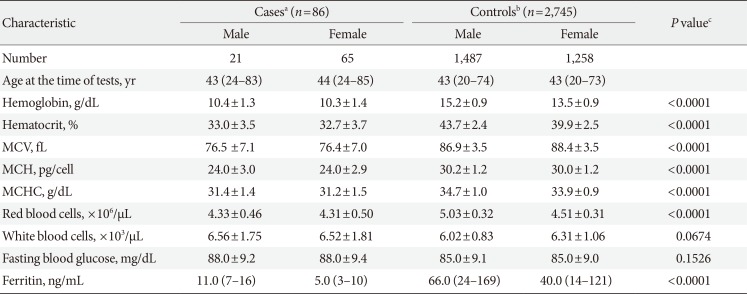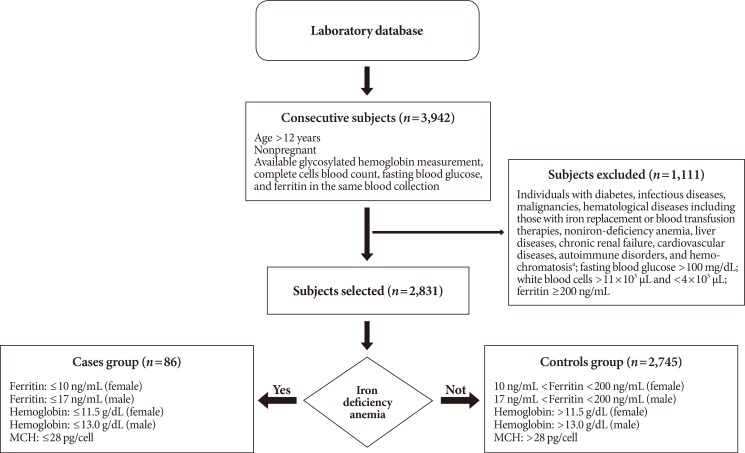1. International Expert Committee. International Expert Committee report on the role of the A1C assay in the diagnosis of diabetes. Diabetes Care. 2009; 32:1327–1334. PMID:
19502545.
3. Horton BF, Huisman TH. Studies on the heterogeneity of haemoglobin. vii. Minor haemoglobin components in haematological diseases. Br J Haematol. 1965; 11:296–304. PMID:
14282066.
4. Eberentz-Lhomme C, Ducrocq R, Intrator S, Elion J, Nunez E, Assan R. Haemoglobinopathies: a pitfall in the assessment of glycosylated haemoglobin by ion-exchange chromatography. Diabetologia. 1984; 27:596–598. PMID:
6530054.

5. Phelps RL, Honig GR, Green D, Metzger BE, Frederiksen MC, Freinkel N. Biphasic changes in hemoglobin A1c concentrations during normal human pregnancy. Am J Obstet Gynecol. 1983; 147:651–653. PMID:
6605685.

6. Ford ES, Cowie CC, Li C, Handelsman Y, Bloomgarden ZT. Iron-deficiency anemia, noniron-deficiency anemia and HbA1c among adults in the US. J Diabetes. 2011; 3:67–73. PMID:
20942846.

7. Sinha N, Mishra TK, Singh T, Gupta N. Effect of iron deficiency anemia on hemoglobin A1c levels. Ann Lab Med. 2012; 32:17–22. PMID:
22259774.

8. English E, Idris I, Smith G, Dhatariya K, Kilpatrick ES, John WG. The effect of anemia and abnormalities of erythrocyte indices on HbA1c analysis: a systematic review. Diabetologia. 2015; 58:1409–1421. PMID:
25994072.
9. Silva JF, Pimentel AL, Camargo JL. Effect of iron deficiency anemia on HbA1c levels is dependent on the degree of anemia. Clin Biochem. 2016; 49:117–120. PMID:
26365695.
10. Khera PK, Smith EP, Lindsell CJ, Rogge MC, Haggerty S, Wagner DA, Palascak MB, Mehta S, Hibbert JM, Joiner CH, Franco RS, Cohen RM. Use of an oral stable isotope label to confirm variation in red blood cell mean age that influences HbA1c interpretation. Am J Hematol. 2015; 90:50–55. PMID:
25293624.

11. Coban E, Ozdogan M, Timuragaoglu A. Effect of iron deficiency anemia on the levels of hemoglobin A1c in nondiabetic patients. Acta Haematol. 2004; 112:126–128. PMID:
15345893.

12. Son JI, Rhee SY, Woo JT, Hwang JK, Chin SO, Chon S, Oh S, Kim SW, Kim YS. Hemoglobin a1c may be an inadequate diagnostic tool for diabetes mellitus in anemic subjects. Diabetes Metab J. 2013; 37:343–348. PMID:
24199163.

13. Madhu SV, Raj A, Gupta S, Giri S, Rusia U. Effect of iron deficiency anemia and iron supplementation on HbA1c levels: implications for diagnosis of prediabetes and diabetes mellitus in Asian Indians. Clin Chim Acta. 2017; 468:225–229. PMID:
27717800.
14. Kim C, Bullard KM, Herman WH, Beckles GL. Association between iron deficiency and A1C Levels among adults without diabetes in the National Health and Nutrition Examination Survey, 1999–2006. Diabetes Care. 2010; 33:780–785. PMID:
20067959.

16. American Diabetes Association. 15. Diabetes advocacy. Diabetes Care. 2017; 40(Suppl 1):S128–S129. PMID:
27979902.
17. Grossman A, Gafter-Gvili A, Schmilovitz-Weiss H, Koren-Morag N, Beloosesky Y, Weiss A. Association of glycated hemoglobin with hemoglobin levels in elderly nondiabetic subjects. Eur J Intern Med. 2016; 36:32–35. PMID:
27594416.

18. Selvaraj N, Bobby Z, Sathiyapriya V. Effect of lipid peroxides and antioxidants on glycation of hemoglobin: an in vitro study on human erythrocytes. Clin Chim Acta. 2006; 366:190–195. PMID:
16325165.

19. Zaka-Ur-Rab Z, Adnan M, Ahmad SM, Islam N. Effect of oral iron on markers of oxidative stress and antioxidant status in children with iron deficiency anemia. J Clin Diagn Res. 2016; 10:SC13–SC19.
20. Del Rio D, Stewart AJ, Pellegrini N. A review of recent studies on malondialdehyde as toxic molecule and biological marker of oxidative stress. Nutr Metab Cardiovasc Dis. 2005; 15:316–328. PMID:
16054557.






 PDF
PDF ePub
ePub Citation
Citation Print
Print





 XML Download
XML Download